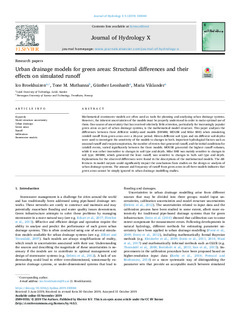| dc.contributor.author | Broekhuizen, Ico | |
| dc.contributor.author | Muthanna, Tone Merete | |
| dc.contributor.author | Leonhardt, Gunther | |
| dc.contributor.author | Viklander, Maria | |
| dc.date.accessioned | 2020-02-18T08:48:33Z | |
| dc.date.available | 2020-02-18T08:48:33Z | |
| dc.date.created | 2020-01-20T16:45:50Z | |
| dc.date.issued | 2019 | |
| dc.identifier.citation | Journal of Hydrology X. 2019, 5 . | nb_NO |
| dc.identifier.issn | 2589-9155 | |
| dc.identifier.uri | http://hdl.handle.net/11250/2642152 | |
| dc.description.abstract | Mathematical stormwater models are often used as tools for planning and analysing urban drainage systems. However, the inherent uncertainties of the models must be properly understood in order to make optimal use of them. One source of uncertainty that has received relatively little attention, particularly for increasingly popular green areas as part of urban drainage systems, is the mathematical model structure. This paper analyses the differences between three different widely-used models (SWMM, MOUSE and Mike SHE) when simulating rainfall runoff from green areas over a 26-year period. Eleven different soil types and six different soil depths were used to investigate the sensitivity of the models to changes in both. Important hydrological factors such as seasonal runoff and evapotranspiration, the number of events that generated runoff, and the initial conditions for rainfall events, varied significantly between the three models. MOUSE generated the highest runoff volumes, while it was rather insensitive to changes in soil type and depth. Mike SHE was mainly sensitive to changes in soil type. SWMM, which generated the least runoff, was sensitive to changes in both soil type and depth. Explanations for the observed differences were found in the descriptions of the mathematical models. The differences in model outputs could significantly impact the conclusions from studies on the design or analysis of urban drainage systems. The amount and frequency of runoff from green areas in all three models indicates that green areas cannot be simply ignored in urban drainage modelling studies. | nb_NO |
| dc.language.iso | eng | nb_NO |
| dc.publisher | Elsevier | nb_NO |
| dc.rights | Navngivelse 4.0 Internasjonal | * |
| dc.rights.uri | http://creativecommons.org/licenses/by/4.0/deed.no | * |
| dc.title | Urban drainage models for green areas: Structural differences and their effects on simulated runoff | nb_NO |
| dc.type | Journal article | nb_NO |
| dc.type | Peer reviewed | nb_NO |
| dc.description.version | publishedVersion | nb_NO |
| dc.source.pagenumber | 13 | nb_NO |
| dc.source.volume | 5 | nb_NO |
| dc.source.journal | Journal of Hydrology X | nb_NO |
| dc.identifier.doi | 10.1016/j.hydroa.2019.100044 | |
| dc.identifier.cristin | 1778338 | |
| dc.description.localcode | Open Access CC-BY | nb_NO |
| cristin.unitcode | 194,64,91,0 | |
| cristin.unitname | Institutt for bygg- og miljøteknikk | |
| cristin.ispublished | true | |
| cristin.fulltext | original | |
| cristin.qualitycode | 1 | |

